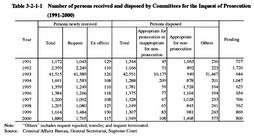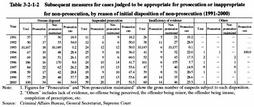| Previous Next Index Image Index Year Selection | |
|
|
(4) Committee for the Inquest of Prosecution 201 Committees for the Inquest of Prosecution have been established nationwide, each with 11 members chosen by lot from the electoral roll for a term of 6 months. By request or ex officio, the Committees review the disposition of non-prosecution made by public prosecutors and make a judgment of the case being "appropriate for prosecution", "inappropriate for non-prosecution" or "appropriate for non-prosecution". Those qualified to make such a request were limited to complainants, accusers, claimants and victims. However, the aforementioned Law for Partial Amendment to the Code of Criminal Procedure and the Law for the Inquest of Prosecution has provided that the spouse, linear relatives or siblings are eligible to make such a request if the victim is dead. The amendment also provides that applicants for review may submit written opinions or related documents to the
Committees. Although judgments of the Committees are not legally binding, Chief Prosecutors of District Public Prosecutors Offices must take any judgment of the case being appropriate for prosecution or inappropriate for non-prosecution into account, and institute public prosecution if he/she considers it necessary to do so. Table 3-2-1-1 shows the trends in the number of persons received and disposed by the Committees during the period from 1991 to 2000. The numbers of persons newly received and disposed were substantially high in 1993 because they included Diet members (40,305 persons) who were charged by a large number of citizens of violations of the Regulation of Money for Political Activities Law with respect to donations to them. Table 3-2-1-1 Number of persons received and disposed by Committees for the Inquest of Prosecution (1991-2000) In 2000, 1,672 persons were newly received for penal code offenses. By type of offense, most of them, or 449 persons, were received for professional negligence resulting in death or bodily injury, followed by 245 persons for forgery of various documents, 168 persons for abuse of authority, 147 persons for bodily injury or bodily injury resulting in death, and 124 persons for fraud, in that order. In contrast, 208 persons were newly received for special law offenses. Most of them, or 62 persons, were received for violations of the Public Offices Election Law followed by 26 persons for violations of the Labor Standards Law and the Commercial Code, respectively (Source: Criminal Affairs Bureau, General Secretariat, Supreme Court).Table 3-2-1-2 shows subsequent measures taken by public prosecutors offices for cases judged to be appropriate for prosecution or inappropriate for non-prosecution, by reason of initial disposition of non-prosecution. In total, 133,777 persons were disposed by the Committees between 1949 (when the Law for the Inquest of Prosecution had taken effect) and 2000, including 16,216 persons judged to be appropriate for prosecution or inappropriate for non-prosecution. Among them, prosecution was instituted for 1,111 persons, and 967 persons were convicted (338 persons to imprisonment and 629 persons to fine) and 76 persons were found not guilty (including Menso adjudication and dismissal of prosecution) (Source: Criminal Affairs Bureau, General Secretariat, the Supreme Court). Table 3-2-1-2 Subsequent measures for cases judged to be appropriate for prosecution or inappropriate for non-prosecution, by reason of initial disposition of non-prosecution (1991-2000) |

